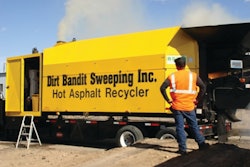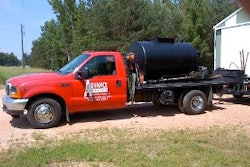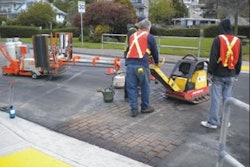
Not every asphalt reclamation application will call for a 950-hp machine. In fact, for jobs where a few inches of asphalt is mixed with the same amount of subbase, a 950 hp machine may be overkill.
However, when you start cutting beyond 6 inches of asphalt, encounter difficult Federal Aviation Administration (FAA) mix design specs or are in a deep-cut soil stabilization job with a lime slurry, having the extra power at hand helps to increase productivity. These bigger, more powerful reclaimer/stabilizers can power through dense material faster and with less effort.
Added power
During March's CONEXPO-CON/AGG show in Las Vegas, Nev., Terex Roadbuilding launched its new Terex RS950B Reclaimer/Stabilizer. With its 12-cylinder, Cat C27 diesel engine offering 950 hp, the RS950B has more than 30% higher horsepower than any other reclaimer/stabilizer in production. "The machine is built for those contractors who encounter jobs requiring high production or the power to cut through more than 10 inches of asphalt and mix it with the existing subgrade," says Chad Harrison, engineer for Terex Roadbuilding.
All that power may also contribute to a more durable machine in the long run. "I like running V-12 engines," comments Bob Durham, president of Durham Stabilization, Elk Grove, Calif. "You're not running at maximum horsepower potential, which makes the engines last about twice as long as 6-cylinder engines. We've run as many as 15,000 hours on V-12 engines in our machines."
The RS950B marks Terex Roadbuilding's reentry into the 800-hp-plus class of reclaimer/stabilizers. In the past, the company offered the 800-hp RS800 with a standard 8-ft cutter. However, with changing engine emission standards, the machine was discontinued a couple of years ago, leaving the 600-hp Terex RS600C as the largest reclaimer/stabilizer in its line.
Many contractors will notice that the new RS950B has a similar look and feel to the RS800. It features the same center-mount cutter design to distribute the machine's full 70,500-lb weight over the cutter housing. A V-belt power band efficiently drives the standard 8-ft cutter at four different cutter speeds - 102, 131, 161 and 200 RPM - to match the torque required for the application. The machine also offers a 10-ft cutter and 58-inch diameter mandrel at both 8- and 10-foot widths for making up to 20-inch deep cuts.
The RS950B boasts 4-wheel drive and steering. A high and low range transmission offers up to 210 ft/min operating speed and a 5.8 mph transit speed.
The machine's new 6.5-inch color display panel gives the operator an easy-to-read overview of critical operating system pressures, including charge pressure for the closed-loop hydraulic system. New mounting location positions the hydraulic tank toward the outside of the frame for quick access and ease of servicing. "The RS950 is much cleaner in terms of hydraulic plumbing and wiring," comments Durham.
Runway application
Now in production, the RS950B Reclaimer/Stabilizer is in the field with customers. The first model off the production line was shipped to California, where Durham Stabilization put it to work on a full-depth reclamation (FDR) project at Travis Air Force Base in Fairfield.
The existing asphalt runway, built to withstand the abuse of heavy military cargo airplane traffic, is being replaced by a concrete runway with asphalt shoulders. At 150 feet wide and approximately 6,000 feet long, this is a challenging reclamation project for Durham Stabilization.
The difficult-to-reclaim asphalt mix included a 0.75-inch aggregate with an AR800 oil, designed under the Marshall mix standards. Just below the asphalt layer included 3 inches of Macadam, a 2- to 3-inch rounded stone with an oil binder. "Macadam is asphalt that dates back to the 1930s and '40s, and it is very difficult to pulverize," explains Durham. "Terex asked us to find something extremely difficult. This is it."
Durham Stabilization travels the west coast and western states including California, Nevada, Utah, Colorado and Arizona for its soil stabilization and asphalt recycling projects. From highways and subways to building pads and parking lots, Durham Stabilization excels in applications like lime and cement stabilization to FDR with asphalt emulsion and foamed asphalt.
For these projects, Durham Stabilization owns a fleet of RS650 and RS800 Reclaimer/Stabilizers. To reclaim the Travis Air Force Base application of 8 inches of military-grade asphalt and 3 inches of Macadam, the company used a combination of RS650, RS800 and RS950 machines. According to Bob Durham, the company's RS800 has been upgraded to include a 12-cylinder, 940 hp engine.
The RS950 went to work on the project and smoothly cut through the difficult material. Compared to the 650 hp of the RS650, the RS950 offered a 40 percent increase in production. When running with the RS800, the new RS950 offered a 13 to 20 percent productivity boost.
"The high horsepower engine is not overkill, and it burns about the same amount of fuel as our 940 hp RS800," says Bob Durham. "There is no other machine built on the market that can cut this application as smoothly as the Terex RS950."
County crusin'
In northern United States, St. Cloud, Minn.-based Road Reclaimers, Inc. travels the markets of Minnesota, North and South Dakota and Iowa for its steady diet of FDR projects. Its reclamation equipment arsenal includes Terex RS600 and RS800 Reclaimer/Stabilizers.
The RS950B was brought in to Sauk Centre, Minn., so Road Reclaimers could evaluate its performance. The county road reclamation project included 6 to 11 inches of BA-1 composition asphalt made with a gravel run aggregate. The machine also mixed in 2 inches of Class-5 gravel, placed on top of the road. "In total, our depth of reclamation averaged between 11 to 13 inches," explains Lanny Schottle, owner of Road Reclaimers, Inc.
Once the reclamation crew finishes, the remaining material is bladed and recompacted, allowing it to be used as the new road base. The base will then be topped with four inches of new hot mix asphalt.
Before using the RS950B, Schottle had mixed first impressions. "It has good power and size, which impressed me," he said. "However, I was a little nervous about fuel consumption."
During the trials, Schottle compared fuel consumption against the company's 800 hp RS800. There was only about a 3-gallon per-hour difference in fuel consumption between the two machines.
When comparing this against the increase in production offered by the RS950B, Schottle's concerns were put to rest. "The 950 hp machine has the potential to (and did) crawl away from the 800 hp machine," comments Schottle. More importantly, the RS950B also maintained the final product sizing that Roads Reclaimers needed.
The operators gave high marks to the new on-board diagnostic screen. "The computer has more diagnostic screens than previous versions, and it runs the elevation and steering to make the machine more user friendly," says Schottle.
Road Reclaimers' Schottle sees some of the best applications for the RS950B as major roadways, county roads and highways. He says that he would rather have 900 hp machines when cutting 6 to 8 inches of asphalt.
"When you are reclaiming this depth, you'll hit pockets of 12 inches that the 600- to 700-hp machines will not get through," explains Schottle. "There's nothing in this world bigger than the RS950B. Either it will do it or it won't get done."



















